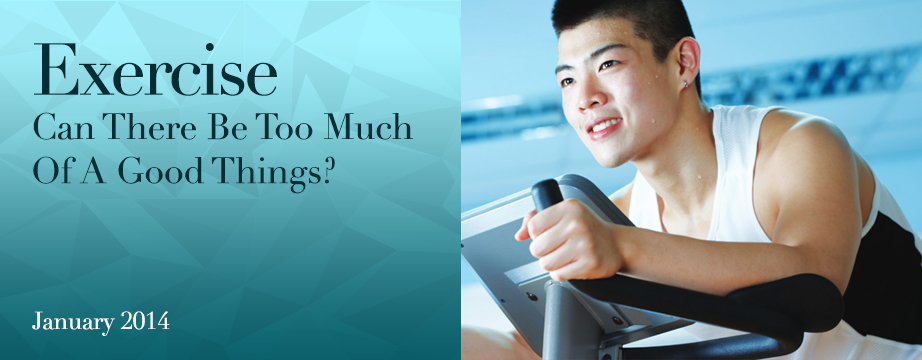
| I must confess that, when I was first approached to write this article, I had some reservations. As someone who spends most of her time extolling the virtues of exercise, I balked at the idea of undoing what little progress I had already made. I was not going to give the couch potatoes another excuse to continue on their road to bad health. |
| But wait. Too much of anything is detrimental to the body. Too much good food, wine, play and even exercise is bad. The tricky task is, how exactly do we define what is too much? |
| When we exercise, we use up nutrients and produce waste products that have to be eliminated by the body. Molecules called free radicals are produced that can cause cell damage if they are not neutralized by other molecules called antioxidants or free radical scavengers. These antioxidants are present naturally in our bodies and are supplemented by diets which are rich in them, such as the pigments and vitamins that are found in brightly colored vegetables like carrots, beetroots, blueberries and tomatoes. Thus it is important to eat a nutritious diet while exercising to protect our bodies against damage. |
| During exercise, proteins are also broken down in the muscles, especially when doing endurance and resistance types of exercises. During rest or recovery periods, when we are not exercising, the muscles then rebuild themselves, becoming stronger and bigger. This is known as the training or remodelling effect. However if there is insufficient rest or recovery between bouts of exercise, the body has no chance to repair itself; then there will be only breakdown, but no repair. This is “overtrainingâ€, and leads to fatigue and an increased chance of injury and illness. |
| It is important to realize that the heart is largely made up of muscle and will respond in a similar fashion with respect to overtraining. In one study, approximately 60 percent of marathon runners were found to have elevations of cardiac enzymes above what is regarded as the upper limit of normals after completing a marathon race. About 40 percent show levels above what is regarded as definitely abnormal. It turns out those who had more pre-race training did not have as much elevations as untrained individuals. These levels usually return to normal after 24 to 48 hours. Recent studies have shown that in ultra endurance athletes (cyclists, marathon runners, triathletes) their hearts undergo changes beyond what is regarded as adaptation to exercise; that is to say, there are abnormal changes like enlargement and weakening of the heart muscle, especially the right-sided chambers. These hearts have microscopic scars that show up on MRI scans. These athletes are also more prone to atrial and ventricular arrhythmias. The microscopic damage that occurs during strenuous exercise never has time to recover or repair itself due to the constant and extremely lengthy periods of training. Micah True, the famous ultra runner who was the inspiration for the book “Born to Run†died during a trail run when he was 58 years old. Autopsy of his heart showed the left side of his heart to be enlarged, a condition termed dilated cardiomyopathy. It was believed that he had died of a cardiac arrhythmia related to the scars in his heart. |
| For the amateur athlete, the more important question to answer is “How much is too much?†To my knowledge, there are no calibrated studies to answer this difficult question. The world’s oldest marathon runner, Fauja Singh, ran his first marathon at the age of 89 ( in a time of 5 hours and 40 minutes) and his last at the age of 100. At 101, he ran his last 10 km race in Hong Kong in a time of 92 minutes and retired from racing. He has run a total of 9 marathons in 11 years and is still alive today. However, we do not have longitudinal studies following athletes throughout their 20 -30 year careers in terms of their cardiac structure and function compared to individuals who do not exercise. If there is damage to the heart caused by exercise, we do not know what is the threshold of exercise above which that damage does occur. |
| We do know that there are definite health benefits in disease prevention with a regular moderate exercise program. Where does that leave us? Moderate exercisers should not have concerns if they have already been cleared for exercise. However, a word of caution to ultra endurance exercisers – due to incompleteness of current knowledge, proceed with caution and get periodic assessments on the effects that such strenuous exertions may have on your health. |
 DR RUTH KAM
DR RUTH KAMCardiologist
MBBS (Singapore)
MRCP (Int Med) (UK)
M Med (Int Med) (Singapore),
FAMS (Cardiology), FRCP (Edin)
Ruth Kam Heart and Arrhythmia Clinic
1 Farrer Park Station Road, #07-11 Connexion
Farrer Park Medical Centre, Singapore 217562
Tel: 6443 0468
www.arrhythmia.com.sg
1 Farrer Park Station Road, #07-11 Connexion
Farrer Park Medical Centre, Singapore 217562
Tel: 6443 0468
www.arrhythmia.com.sg



